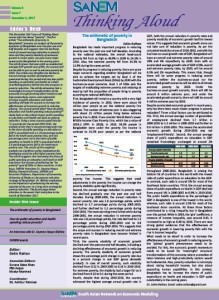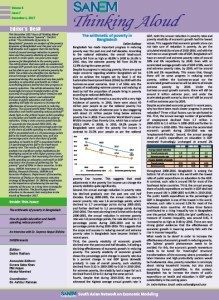
Thinking Aloud: Volume IV, Issue 7
 This December 2017 issue of Thinking Aloud comes with the theme “poverty”. The first article “The arithmetic of poverty in Bangladesh” presents an analysis of the poverty dynamics of Bangladesh over the past one and half decades and suggests that the declining trend of annual average reduction in poverty rates and the poverty elasticity of economic growth in recent years can pose some major concerns for Bangladesh in the coming years. The article shows that even with an accelerated average GDP growth rate of 8%, the country will not be able to put an end to extreme poverty by 2030. The article also identifies the decline in the annual average number of employment generated during this period and very low public spending on education and health as critical contributing factors behind the slow progress in poverty reduction. The article advocates that a meaningful structural transformation of the economy through fostering labor-intensive and high-productivity sectors and a substantial increase in public education and health spending will help the country to increase the effectiveness of economic growth in reducing poverty. The second article titled “How do public education and health spending reduce poverty?” sheds light on the critical impact public spending on education and health can have on poverty reduction. Using a cross-country panel data for 72 countries for the period 1981-2015, the analysis shows that a one percentage point rise in the share of public spending on education in GDP is associated with a 1.33 percentage points fall in the head-count poverty rate, and one percentage point rise in the share of public spending on health in GDP is associated with a 2.4 percentage points fall in the head-count poverty rate. The results of this empirical analysis have significant policy implications for developing countries with higher poverty rates. The article suggests that increasing the share of public spending on education and health in GDP may boost the chances of achieving the “no poverty” goal of SDGs in these countries. In this issue, SANEM interviews Dr. Sayema Haque Bidisha, Research Director, SANEM and Associate Professor, Department of Economics, the University of Dhaka on the poverty reduction strategy of Bangladesh. Dr. Bidisha emphasizes the importance of enhancing the earning capacity of the poor as a long-term strategy for poverty reduction. The fourth page draws attention to the events that took place in the month of November 2017.
This December 2017 issue of Thinking Aloud comes with the theme “poverty”. The first article “The arithmetic of poverty in Bangladesh” presents an analysis of the poverty dynamics of Bangladesh over the past one and half decades and suggests that the declining trend of annual average reduction in poverty rates and the poverty elasticity of economic growth in recent years can pose some major concerns for Bangladesh in the coming years. The article shows that even with an accelerated average GDP growth rate of 8%, the country will not be able to put an end to extreme poverty by 2030. The article also identifies the decline in the annual average number of employment generated during this period and very low public spending on education and health as critical contributing factors behind the slow progress in poverty reduction. The article advocates that a meaningful structural transformation of the economy through fostering labor-intensive and high-productivity sectors and a substantial increase in public education and health spending will help the country to increase the effectiveness of economic growth in reducing poverty. The second article titled “How do public education and health spending reduce poverty?” sheds light on the critical impact public spending on education and health can have on poverty reduction. Using a cross-country panel data for 72 countries for the period 1981-2015, the analysis shows that a one percentage point rise in the share of public spending on education in GDP is associated with a 1.33 percentage points fall in the head-count poverty rate, and one percentage point rise in the share of public spending on health in GDP is associated with a 2.4 percentage points fall in the head-count poverty rate. The results of this empirical analysis have significant policy implications for developing countries with higher poverty rates. The article suggests that increasing the share of public spending on education and health in GDP may boost the chances of achieving the “no poverty” goal of SDGs in these countries. In this issue, SANEM interviews Dr. Sayema Haque Bidisha, Research Director, SANEM and Associate Professor, Department of Economics, the University of Dhaka on the poverty reduction strategy of Bangladesh. Dr. Bidisha emphasizes the importance of enhancing the earning capacity of the poor as a long-term strategy for poverty reduction. The fourth page draws attention to the events that took place in the month of November 2017.
Link: Thinking Aloud: IV, Issue7
Tag: poverty, public spending, SDGs



